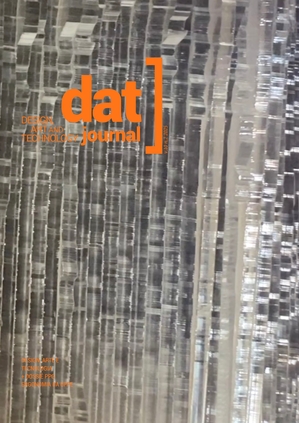A Synergy Between Systems Thinking and Design Thinking
A Case Analysis of the Systems Design Firm IDEO
DOI:
https://doi.org/10.29147/datjournal.v10i2.966Keywords:
Design Thinking, Systems Thinking, Synergy, IntertwiningAbstract
Design Thinking and Systems Thinking are two sets of theories and guidelines that address the organization and standardization of elements. While Design Thinking is based on the organization of processes in stages and phases in order to solve a problem that involves a context and mainly people, Systems Thinking seeks to understand the relationships of interconnected entities and how they exchange information between themselves and between the environment in which they are inserted. Both premises have similar and complementary guidelines, which can be intertwined through the so-called Systems Design. This work aims to analyze the intertwining between Design Thinking and Systems Thinking through the analysis of two case studies of projects from the company IDEO based on points established through a qualitative and exploratory literary review.
Downloads
References
ACKOFF, R. L. Towards a System of Systems Concepts. Management Science, v. 17, n. 11, p. 661–671, jul. 1971. DOI: https://doi.org/10.1287/mnsc.17.11.661
AGAZZI, Evandro. Systemic thinking. Mario Bunge: A Centenary Festschrift, p. 222-240, 2019. DOI: https://doi.org/10.1007/978-3-030-16673-1_13
ALVES, J. B. da M. TEORIA GERAL DE SISTEMAS: em busca da interdisciplinaridade. Florianópolis: Instituto Stela, 2012. 179 p.
ARCHER, B. Design as a discipline. Design Studies, v. 1, n. 1, p. 17–20, jul. 1979. DOI: https://doi.org/10.1016/0142-694X(79)90023-1
ASILI BLUEPRINT. Relatório Asili, 2015. Asili: Co-designing an End to Childhood Mortality. Disponível em: <https://s3files.core77.com/files/pdfs/2015/34451/242573_PhvT AVg7R.pdf>. Acesso em: 18 mai. 2024.
ASIMOW, M. Introduction to Design. Washington, D.C: Photoduplication Service, Library of Congress, 1976. p. 1–135.
BERTALANFFY, L. V. General System Theory: Foundations, Development, Applications. New York: Braziller, 1968.
BROWN, T. Change by design: How design thinking creates new alternatives for business and society. New York: Collins Business ; Enfield, 2009.
CAPRA, F.; LUISI, P. L. The systems view of life: A unifying vision. Cambridge, England: Cambridge University Press, 2016.
CROSS, N. Developments in Design Methodology. Chichester, England: John Wiley & Sons, 1984.
DA SILVA, Igor Castellano. Congo, a Guerra Mundial Africana: conflitos armados, construção do estado e alternativas para a paz. Leitura XXI, 2014.
DESIGN KIT. Design Kit, 2014. Um negócio sustentável de saúde, agricultura e água de propriedade comunitária na República Democrática do Congo. Disponível em: https://www-designkit-org.translate.goog/case-studies/6.html?_x_tr_sl=auto&_x_tr_tl=pt&_x_tr_hl=pt-BR&_x_tr_pto=wapp. Acesso em: 18 mai. 2024.
DESIGN KIT. Moneythink Mobile, 2015. Designing Digital Tools to Build Financial Literacy. Disponível em: https://www.designkit.org/case-studies/3.html. Acesso em: 18 mai. 2024.
DESIGNER AWARDS. Designer Awards, 2015. Asili: Co-designing an End to Childhood Mortality. Disponível em: https://designawards.core77.com/Design-for-Social-Impact/34451/Asili-Co-designing-an-End-to-Childhood-Mortality. Acesso em: 18 mai. 2024.
ET, B.; IDEO. Human centered design : toolkit ; HCD. S.L.: Ideo, 2011.
FORRESTER, J. W. Urban Dynamics. Nova Iorque, NY, USA: Productivity Press, 1995.
IDEO ([S.I]). Design Thinking for Educators. 2. ed. [S.I.]: Ideo Llc, 2012, 2012. 81 p. Disponível em: https://page.ideo.com/design-thinking-edu-toolkit. Acesso em: 08 maio 2024.
IDEO. 10 Year Impact Report. 2024. Disponível em: https://impact.ideo.org/. Acesso em: 11 jul. 2024.
IDEO.ORG. Ideo.org, 2014. The Community Enterprise That’s Creating New Possibilities in the DRC. Disponível em: < https://www.ideo.org/project/asili >. Acesso em: 18 mai. 2024.
JONES, J. C. Design Methods. [s.l.] John Wiley & Sons, 1970.
JONES, P. H. Systemic design principles for complex social systems. Em: Translational Systems Sciences. Tokyo: Springer Japan, 2014. p. 91–128. DOI: https://doi.org/10.1007/978-4-431-54478-4_4
KAZMIERCZAK, E. T. Design as meaning making: From making things to the design of thinking. Design issues, v. 19, n. 2, p. 45–59, 2003. DOI: https://doi.org/10.1162/074793603765201406
LAWSON, B. How designers think. [s.l.] Architectural Press, 2017.
MILLER, William R. A definição de design. Tradução de João de Souza Leite. Acedido em, v. 6, n. 03, p. 2020, 1988.
MATURANA, H. R.; VARELA, F. G. De máquinas e seres vivos: autopoiese, a organização do vivo. 3. ed. Porto Alegre: ARTMED, 1997.
MEADOWS, D. H. Thinking in Systems : a Primer. London ; Sterling, Va: Earthscan, 2009.
MONEYTHINK. MoneyThink, 2015. About us. Disponível em: < https://moneythink.org/about-us/our-story/ L>. Acesso em: 18 mai. 2024.
MUGADZA, G.; MARCUS, R. A systems thinking and design thinking. Expert journal of business and management, v.7, n. 1, p. 1–10, 2019.
NORMAN, D. The Design of Everyday Things. Basic Books, 1988.
REDSTRÖM, J. Towards user design? On the shift from object to user as the subject of design. Design studies, v. 27, n. 2, p. 123–139, 2006. DOI: https://doi.org/10.1016/j.destud.2005.06.001
SIMON, H. A. The sciences of the artificial. Cambridge, Massachusetts: The Mit Press, 1969.
VARELA, F. G.; MATURANA, H. R.; URIBE, R. Autopoiesis: The organization of living systems, its characterization and a model. Biosystems, v. 5, n. 4, p. 187–196, maio 1974. DOI: https://doi.org/10.1016/0303-2647(74)90031-8
VIAL, S. Design and Creation: Outline of a Philosophy of Modelling. Wikicreation, Institut Acte UMR 8218 (Sorbonne Paris 1 University and CNRS)/LabEx CAP. 2013.
VITTA, M.; NELLES, J. The meaning of design. Design Issues, p. 3-8, 1985. DOI: https://doi.org/10.2307/1511413
VON BERTALANFFY, Ludwig. The theory of open systems in physics and biology. Science, v. 111, n. 2872, p. 23-29, 1950. DOI: https://doi.org/10.1126/science.111.2872.23
ZOLTOWSKI, C. B.; OAKES, W. C.; CARDELLA, M. E. Students’ ways of experiencing human centered design. Journal of Engineering Education, v. 101, n. 1, p. 28-59, 2012. DOI: https://doi.org/10.1002/j.2168-9830.2012.tb00040.x
Downloads
Published
How to Cite
Issue
Section
License
Copyright (c) 2025 DAT Journal

This work is licensed under a Creative Commons Attribution 4.0 International License.


























